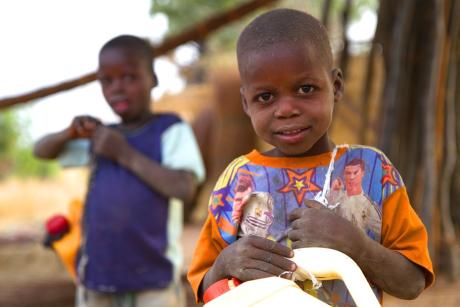
Taking measurements to assess growth and nutritional status of infants and mothers
Published July 6, 2014, last updated on October 5, 2017 under Voices of DGHI
By Elizabeth Knippler '16
- Make a plan for when and where you will meet, how you will coordinate measurements and surveys, and expect to finish reasonably within four hours. Throw all those plans out the window.
- Be patient when no one comes at the hour you called the blood draw. Be patient when the moms slowly start to arrive 45 minutes later. Be patient when two hours in, half of the women still aren't there. Be patient as you walk with all the weighing supplies and blood draw equipment- dragging along the wonderfully accommodating lab tech, translator, and VHT (Village Health Team) guide- to the remaining women's houses. Be grateful when they share their precious time and stories with you.
- Try not to make the babies cry. Know that some of them will wail anyway, and measure them as quickly as possible while saying over and over again "It's okay, baby. We're almost done!" Cherish time with the happy, babbling ones who grab your finger, smile with toothless grins, and look up at you with wide eyes.
- Bring extra candy ("sweeties") for the many siblings and neighborhood kids who will surround you, line up on the stoop next to you as you survey, sneak a brush against your skin, offer you a few (slobbery) kernels of their corn, or snuggle up next to you in a chair.
- Practice your basic Luganda phrases. Smile as the neighborhood all laughs and claps when you introduce yourself with your clan name, respond you are doing well, and thank the generous women over and over again.
- Be creative and resourceful as you navigate your surroundings. Hang baby scales from mango trees, door frames in churches, and any sturdy branch you can find. Ask politely (and offer sodas if you can) to borrow neighbors' flat concrete porches and doors to set up the weighing scale and measuring tape.
- Listen with admiration and interest as women recount giving birth alone in their kitchen and other challenges you could never imagine, as mothers younger than yourself lovingly care for their families, and as you learn about local remedies and disease knowledge. Decide TLC really needs to drop "A Baby Story" and start a new series called "Strong Ugandan Mothers." Be grateful TLC isn't actually here filming because they'd ruin the atmosphere that has made you fall in love with Uganda.
- Keep your eyes wide open and take everything in as you boda into the villages and walk from house to house. Learn the Luganda names of tall trees, flowering bushes, and leafy vegetables that surround you. Take note of the different vegetation and distinct feel of each village. Take a few pictures, but know that they will never capture the beauty that you see.
- Chat with the VHTs about how they got involved with the volunteer program, what types of challenges they face, what type of health issues they see commonly in the community, and interesting stories they have to share. Admire their ability to identify women on the list you hand them, their knowledge of the shortcuts that weave between houses, their assistance as they help you place wriggling, naked babies into scales, and their patience as you take up their entire morning.
- Return home exhausted and sweaty, knowing you have hours of data entry ahead of you, schedules to re-organize, and details to plan (which will change again in a few days). Smile, because you wouldn't have this experience any other way.


